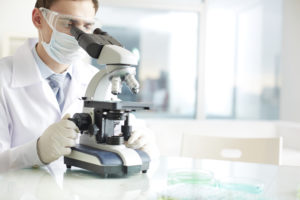Top T1D Advances for 2016

As the year closes, JDRF looks back with pride at some significant developments made possible by your support to advance the cure, prevention and treatment of type one diabetes (T1D.)
In April, Ramnik Xavier, M.D., Ph.D., of the Broad Institute in Boston, published a paper demonstrating a link between the makeup of one’s gut bacteria, collectively known as the microbiome, and the chance of developing T1D. Dr. Xavier’s team examined biological samples from babies and toddlers from three countries to see whether differences in sanitation standards affected the bacterial populations in the babies’ digestive systems. They found multiple species of bacteria that stimulate the immune system in samples from all three countries. They also found that in the countries where sanitation and the standards of living are higher there was a prevalence of microbes that actually block immune stimulation. The team hypothesizes that lack of immune stimulation leaves individuals vulnerable to inflammation that may contribute to the increase in immune diseases, including T1D. This project and other like it provide greater insight into how T1D develops and may help us use the microbiome to help prevent the disease.
One of the biggest stories in T1D research this year was the publication in June of the first results of the Fr1da study, a general population T1D trial in Germany screening children for beta cell autoantibodies during routine pediatrician visits at ages 3 or 4. Of the 43,000 children examined during the first 18 months of the trial, 144 were found to have two or more autoantibodies—an indicator of incipient T1D—while they were still asymptomatic. With to follow-up counseling, none of the autoantibody positive children who developed symptomatic disease experienced an episode of diabetic ketoacidosis, a potentially deadly acute complication of T1D. Fifty-two of the children with multiple autoantibodies were subsequently enrolled into a study to determine if daily doses of oral insulin taken while most beta cells are still functional can prevent progress to symptomatic disease. Identifying children already on the path to T1D before they become symptomatic improves their early care, allows them to participate in intervention studies and is a key component of JDRF’s strategy to prevent T1D.
Also in June, JDRF and Antidote announced the launch of the Clinical Trials Connection tool, the result of a partnership aimed at increasing participation in clinical trials, an ideal way for people to contribute to the development of new therapies to cure, prevent and treat T1D. The tool, available on the JDRF.org website, asks people to answer a few questions about themselves to quickly and easily match them to trials that are right for them. This simple tool will speed enrollment in trials that will hasten the development of better treatments and eventually curative and prevention therapies for T1D.
Another major achievement was the U.S. Food and Drug Administration’s (FDA’s) September approval of industry partner Medtronic’s MiniMed 670G hybrid closed-loop artificial pancreas system, the first ever approved to automate insulin dosing to reduce high blood sugar levels. In clinical trials, the 670G system proved to be highly effective at keeping people with T1D within their desired blood sugar range, especially at night, the most dangerous time for blood sugar lows. JDRF did not fund the commercial development of the 670G, which could be available as early as next spring, but supported critical early work that the system is based on and worked with the FDA to develop guidance that defined the path for development of the technology.
Two late-breaking developments were in the field of cell conversion; chemically stimulating pancreatic alpha cells to change into functional beta-like cells with an eye toward potentially regenerating insulin-producing beta cell mass. Two JDRF-funded researchers say they’ve found triggers to spark such conversions. French researcher Patrick Collombat, Ph.D., found that GABA, a naturally occurring chemical and common dietary supplement, triggers the conversion of mouse alpha cells into beta-like cells and appears to have the same effect on human islets transplanted into mice. Investigator Stefan Kubicek, Ph.D., at the Austrian Academy of Sciences realized similar results using a type of FDA-approved anti-malarial drug called artemisinins. These results suggest it may be possible to “re-train” alpha cells that continue to survive in the pancreas of a person with T1D into insulin-producing cells, a critical step toward a cure.
Why It Matters
The advances discussed here result from our supporters’ confidence that JDRF’s work makes a tangible difference in their lives. Years of investment to support the best investigators working in the T1D sphere is yielding real-world results. When we at JDRF look back at the progress made this year, we are profoundly grateful for all you do. Thank you.
